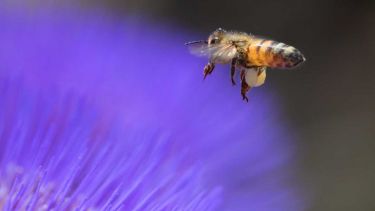- University of Sheffield spin-out, Opteran Technologies, has collaborated on a new paper which highlights that insect intelligence can inspire an alternative to mainstream approaches to robot intelligence
- The authors suggest that solving the limitations of today’s state of the art AI requires drawing inspiration from how brains work in insects such as honeybees, whose intelligent behaviours enable them to implement diverse locomotion strategies, complex visual systems, robust navigation strategies and co-operative social behaviours.
- Opteran is harnessing this intelligence to deliver the third wave of AI, genuine brain biomimicry, which could be the future of autonomous systems
Opteran Techologies, a University of Sheffield spin-out based on research developed in the Department of Computer Science, working in collaboration with Delft University of Technology and the University of Washington, has published a new paper in Science Robotics which highlights several shortcomings of mainstream approaches to robot intelligence.
The new paper argues that insect intelligence can inspire a promising alternative to classic methods in robotics for the artificial intelligence (AI) systems that enable autonomy in robots. The review shows insects are the perfect brains to study because they are small and thus hyper-efficient, yet still very competent, and capable of feats of autonomy, navigation and decision making that far outstrip what can be done with mainstream approaches.
The authors suggest that solving the limitations of today’s state-of-the-art AI requires us to draw inspiration from how brains work, rather than caricatures of how parts of the brain work. For example, deep learning is based on a simple learning rule and information processing motif very loosely inspired by the visual cortex in the primate brain. Consequently, the widespread adoption of deep learning has meant that all problems, including autonomous control, are treated as problems of perception, but animals do not use the visual cortex exclusively to complete all tasks.
Importance of parsimony to insect intelligence
Taking inspiration from insect intelligence overcomes limitations in both deep learning and photogrammetry models mainly thanks to the insects employing minimalistic yet robust solutions to achieve successful behaviour in complex, dynamic and often hostile environments. Termed parsimony, this minimalistic approach is highly energy efficient and is made up of three aspects:
● Embodiment: This is interpreted as the design of the body, including the sensor and actuator apparatus. By doing so, cognitive load can be reduced or even eliminated entirely.
● Sensory-motor coordination: The brain evolved to control motion as organisms gained the ability to move; conversely, evolution drove animals to move in such a way as to make the task of the brain easier.
● Computational hardware: fitting types of cognitive computation to the appropriate substrate, just as in real brains.
Important in achieving this parsimony is that insect intelligence – just like that of more complex animals like humans – is characterised by “embodied cognition”. It acknowledges that intelligence does not depend only on the brain, but is crucially shaped by the insect’s embodiment, that is, its body and sensory apparatus. Furthermore, it implies that insect intelligence builds on the capability to interact with the world, combining feedback from a diverse array of sensors and exploiting the closed loop of sensory inputs and actions to simplify the cognitive operations performed by the brain. Finally, social insects live together in colonies and are thus able to perform tasks that go beyond the limits of their individual capabilities.
James Marshall, Professor of Theoretical and Computational Biology at the University of Sheffield and Chief Scientific Officer at Opteran, said: “Although insects such as honeybees only have 1 million neurons their behaviours are intelligent, enabling them to implement diverse locomotion strategies, complex visual systems, robust navigation strategies and co-operative social behaviours.
“At Opteran we are harnessing this intelligence to deliver the third wave of AI, genuine brain biomimicry, which we believe is the future of autonomous systems. We have already made significant advances in areas such as gaze stabilisation, collision avoidance for dynamic obstacles, navigation and decision making, so we are confident we will deliver on our full-stack autonomy solution this year.”
Opteran is already adopting the approach outlined in the paper to deliver breakthrough innovations in autonomous systems. It has developed patent-pending electronic image stabilisation technology to support its patented insect-derived optic flow, collision avoidance and navigation algorithms (embodied cognition). Its navigation technology links awareness of space with perception to effectively explore environments (sensory-motor co-ordination) and thanks to its computational substrate it can achieve unrivalled processing speeds, size, weight, power and cost.
The article is co-authored by:
G.C.H.E. de Croon, Micro Air Vehicle laboratory, Faculty of Aerospace Engineering, TU Delft
J.J.G. Dupeyroux, Micro Air Vehicle laboratory, Faculty of Aerospace Engineering, TU Delft
S.B. Fuller, Autonomous Insect Robotics Laboratory, Department of Mechanical Engineering and Paul G. Allen School of Computer Science, University of Washington, Seattle, USA.
J.A.R. Marshall, Chief Scientific Officer, Opteran and Professor of Theoretical and Computational Biology in Complex Systems Modelling Group, Department of Computer Science, University of Sheffield, United Kingdom

